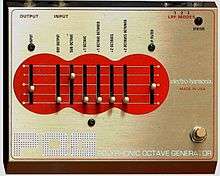Pitch shift
Pitch shifting is a sound recording technique in which the original pitch of a sound is raised or lowered. Effects units that raise or lower pitch by a pre-designated musical interval (transposition) are called pitch shifters.

Pitch/time shifting
The simplest methods are used to increase pitch and reduce durations or, conversely, reduce pitch and increase duration. This can be done by replaying a sound waveform at a different speed than it was recorded. It could be accomplished on an early reel-to-reel tape recorder by changing the diameter of the capstan or using a different motor. As technologies improved, motor speeds could be controlled by electronic servo system circuits. This arrangement using “vari-speed” capstan motors allowed the speed change to be achieved more simply.[1] As for vinyl records, the same thing can be done: placing a finger on the turntable to give friction will retard it, while giving it a "spin" can advance it.
Pitch shifter and harmonizer
A pitch shifter is a sound effects unit that raises or lowers the pitch of an audio signal by a preset interval. For example, a pitch shifter set to increase the pitch by a fourth will raise each note three diatonic intervals above the notes actually played. Simple pitch shifters raise or lower the pitch by one or two octaves, while more sophisticated devices offer a range of interval alterations. Pitch shifters are included in most audio processors today.
A harmonizer is a type of pitch shifter that combines the pitch-shifted signal with the original to create a two or more note harmony.
In digital recording, pitch shifting is accomplished through digital signal processing. Older digital processors could often only shift pitch in post-production, whereas many modern devices using computer processing technology can change pitch values virtually in real time.[2]
Pitch correction is a form of pitch shifting and is found in software such as Auto-Tune and Melodyne to correct intonation inaccuracies in a recording or performance. Pitch shifting may raise or lower all sounds in a recording by the same amount, whereas in practice, pitch correction may make different changes from note to note.[3]
Notable uses
Numerous cartoons have used pitch shifters to produce distinctive animal voices. Alvin and the Chipmunks recordings with David Seville (aka Ross Bagdasarian) were created by recording vocal tracks at slow speeds, then playing them back at normal speeds. Voice artist Mel Blanc used pitch shifting techniques to create the voices of Tweety and Daffy Duck.[4]
One notable early practitioner of pitch shifting in music is Chuck Berry, who used the technique to make his voice sound younger. Many of the Beatles' records from 1966 and 1967 were made by recording instrumental tracks a half-step higher and the vocals correspondingly low. Examples include "Rain", "I'm Only Sleeping", and "When I'm Sixty-Four".
Electronic musician Burial is known for including pitch-shifted samples of vocal melodies in his songs.[5]
Goregrind and occasionally death metal use vocals that are often pitch-shifted to sound unnaturally low and guttural.
The famous bass intro to the song "Seven Nation Army" by The White Stripes, is the result of guitarist Jack White playing an electric guitar through a pitch shifting effects pedal set to an octave below. The band was a duo, who lacked a bassist and had never previously used one in any of their music, choosing instead to mimic the sound of a bass guitar.[6]
In the single "Diane Young" by Vampire Weekend, the lead singer Ezra Koenig makes use of a pitch shifter in the chorus.
References
- "Analog Tape Recorders". UCSC Electronic music studios 1996. Retrieved 15 February 2011.
- "Voice Modelling Processor". Sound on Sound 2002. Retrieved 17 February 2011.
- "Making Tracks: Pitch Doctor". Penton Media - date undisclosed. Archived from the original on 5 August 2010. Retrieved 17 February 2011.
- "What makes Daffy Duck?". Top looney golden age cartoons - date undisclosed. Archived from the original on 8 June 2011. Retrieved 17 February 2011.
- Jenkins, Pete (July 2010). "Dubstep Basics: An Introduction To Dubstep Production". Sound On Sound.
- Martin, Daniel (13 May 2013). "20 Things You Might Not Know About 'Seven Nation Army'". NME. Retrieved 19 January 2017.
External links
- Pitch shifting explained
- Time Stretching And Pitch Shifting of Audio Signals by Stephan M. Bernsee
- pitchshift.js from KievII Pitch shifter algorithm in Javascript, from KievII library